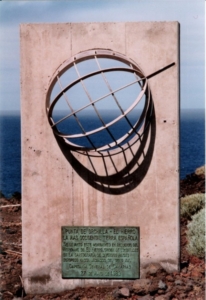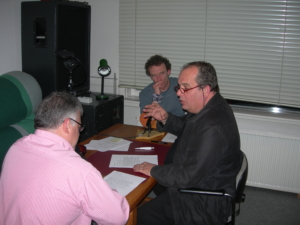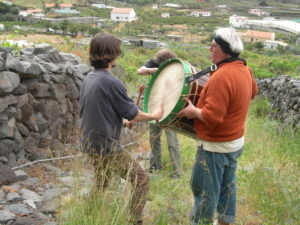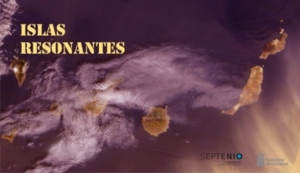Una Hora
Radioplay about the 0-meridian on the Canary Island EL Hierro
2009/2012 (55′47″)
Radio phonic work
The radio phonic work ”Una Hora” deals with the change of time consciousness and the cultural effects in the society, hereby caused.
The meridian – midday line – connects all places on the map, which have noon at the same time. Till the end of the 19th century the Zero Line of Longitude of the earth ran across the Orchilla lighthouse, which lies on the Canary island El Hierro and which forms the southernmost point of Europe. Worldwide all ships used this point for orientation and to specify their co-ordinates. For sailors, El Hierro therefore was not an unknown island, but an important interface, which at that time connected Europe with the world imaginary. In 1884 the Orchilla time was changed into the Greenwich Mean Time (GMT) in England. The Zero Line of Longitude ran and runs today through “the primary transit” instrument (main telescope) at the Royal Observatory in Greenwich (near London).
From here there are 180 meridians in eastern and western direction, which run parallel to the Zero Line of Longitude and 90 latitudes in the south and the north, which run parallel to the equator.
The calibration and measuring point were thus shifted from the southern point of Europe to England. The hegemony of England, which at that time governed the world market by ship and expanded its Commonwealth untiringly, was thus emphasised.
Main play:
“Una Hora” draws a three-way dramatic tensions arc:
- Following the book ”The Island of the day before” by Umberto Ecco stories are told of Roberto de la Grive and Padre Caspar Wanderdrossel. The shipwrecked and abandoned Roberto wanted to solve the secret of the noises aboard, and behind the summerhouse of the birds he discovered a chamber full of clocks. His part is not shown with texts, but is characterised with sounds. Ecco describes Padre Caspar Wanderdrossel as a well-educated practical man who would like to solve the longitude problem. In ”una hora” he is the explorer, who wants to understand the change of time and its effects. His short syllabic slots are in English.
- The second tensions arc is based on the original proceedings, a reporter describes the occurrences during the „Prime Meridian Conference“ held in Washington DC in 1884. Here the decision was made to move the Zero Meridian from El Hierro to Greenwich. Important are the comments made by the French delegates Mr. A. Lefaivre and Mr. P. Janssen, who opposed this decision.
- In a discussion on El Hierro between Luis Espinosa Krawany and the historian Baudilio, the influence the Orchilla time had on this island at that time is outlined. Sounds, recorded in and around the still functioning Orchilla lighthouse, can be heard in the background.
The three dramatic tensions arcs are interlocked with one another.
About the music:
You hear three drum players. These specific drums are the original instruments used at festivals on El Hierro. The drum players play in front of the 8 kilometers long wall, the „Risco de Tibataje“. The rhythms are derived from the ancient Bajada melody, which can be heard on El Hierro every four years. The theme “Islas Resonantes” is here very clearly interpreted.
Some of the sounds, heard in the background, are also recorded on El Hierro, like the high flute tones of the common kestrel, the gecko and the volcanic pipes near the village Echedo.
Sequel:
The duration of “Una hora” is one hour. When I was making the recordings, time in El Hierro was one hour earlier in relation to the Central European Time (MEZ). However, time in El Hierro and in Greenwich is the same!
“Una hora” mediates time in the flow of events of past and present.
“Una hora” is mainly conceived in Spanish.
“Una hora” is a format 5.1 composed concert. For the radio broadcast a stereophonic version was provided.
“Una hora” is a radio phonic composition, which represents the historical perspectives as well as their interpretation in music and in documentary (interviews). All this with the ears of the lighthouse, which sends its light vectors and lets ships draw their courses.
“Una hora” was first composed in a 30-minute version for the project “Islas resonantes” (soundscapes from the Canary Islands), as all participants were given a maximum of this duration. In 2012, the final 1 Hour version (Stereo and 5.1) was completed, as it corresponds to the title of the piece.
Some of the sound recordings made in April 2009 during the project “Islas resonantes” commissioned by Septenio Canario (Gobierno de Canarias) were also used for the project Tibataje and El Risco






